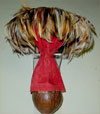Polynesia - the 1000 islands
Where does polynesian dance originate from?
Polynesia is a large grouping of over 1,000 islands scattered over the central and southern Pacific Ocean. Polynesia may be described as a triangle with its corners at Hawaii, New Zealand and Rapa Nui (Easter Island). Inside are the islands Samoa and Tonga, the Cook Islands and French Polynesia.
The main dance forms that we perform are:
Hula (Hawaii)
The origins of Hula start in the time of Hawaii when there was no written language, and instead the history was passed down throuch chants (songs) known as "mele". The hula dance is a visualization of the store being told; traditional hula involces stores of creation, while modern hula can be more hands on (a story on how to fish or how a girl loves a guy). Hula is often graceful and uses hand movements and guestures to tell a story.
Ori and Ote'a Dance (Tahitian)
The Tahitian dance is very similar in concept, except that ote'a is much faster, the music involves dramatic drum beats, and the dancers use a move similar to "hip shaking." Tahitian costumes are known for their beautiful tall headdresses, grass skirts and hand tassels. The Otea dancers move their hips to fast energetic drum beats.
New Zealand Maori Dance
The best known prop for Maori dance are the poi balls, which are attached to long cords and swung in cirles around the poi dancers. At night (and outside, please), they can be set on fire for a spectacular display.
A Kapa haka is a group gathered to practise and perform the songs and dances of the Maori people of New Zealand. Kapa means "row" in Maori, and much of the performance is given with the performers in rows.
Canoe dances tell the story of the Maori people's migration by canoe from Polynesia to New Zealand.
The best known prop for Maori dance are the poi balls, which are attached to long cords and swung in cirles around the poi dancers. At night (and outside, please), they can be set on fire for a spectacular display.
A Kapa haka is a group gathered to practise and perform the songs and dances of the Maori people of New Zealand. Kapa means "row" in Maori, and much of the performance is given with the performers in rows.
Samoa Dance
The story about life in Samoa is told through clapping and slapping in Sa Sa dances. Lapa sticks are used for rhythm dances. And a dramatic fire or knife dancer leaps and spins while juggling knifes or flaming torches to a rapid, primeval drum beat.
Instruments for Hawaiian Hula Dance
The most commonly used instruments are
Ipu
 A gourd drum. It gourd drum helps in keeping a steady beat to the hula. It can be used standing.
A gourd drum. It gourd drum helps in keeping a steady beat to the hula. It can be used standing.
The larger Ipu Heke (or pa ipu ), or double gourd, is used mainly by the Kumu Hula (teacher) in chants, or by the ho`opa`a (senior student, dance leader). It is a percussion instrument made by joining two ipu, one atop the other. While sitting, the player plays with the fingers and palm, and it can be lifted and "stomped" to the ground to make a loud sound.
'Uli'uli
 A feather-decorated coconut rattle.
A feather-decorated coconut rattle.
Pu'ili
 A split bamboo rattle, used to enhance the rhythm of the hula being performed.
A split bamboo rattle, used to enhance the rhythm of the hula being performed.
'Ili'ili
 Waterworn stone pebbles, two in each hand, played in a manner similar to castanets. The two stones are placed in each hand, one between the thumb and pointer, and other is held by the middle, ring and baby fingers. They are claped together to make a rhythmic sound.
Waterworn stone pebbles, two in each hand, played in a manner similar to castanets. The two stones are placed in each hand, one between the thumb and pointer, and other is held by the middle, ring and baby fingers. They are claped together to make a rhythmic sound.
Kala'au
 The hula sticks are used mostly in Kahiko, or Ancient, performances.
The hula sticks are used mostly in Kahiko, or Ancient, performances.


